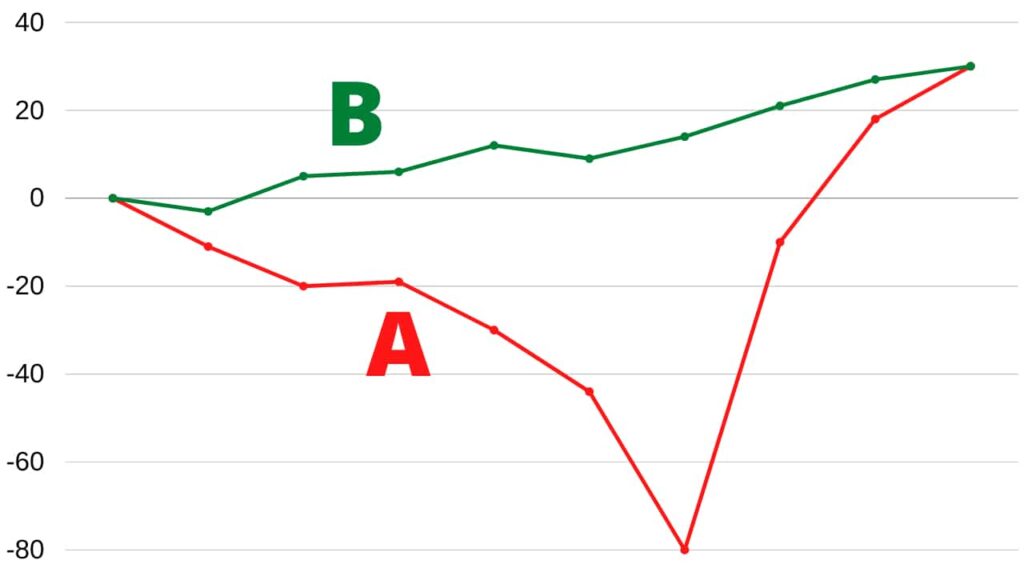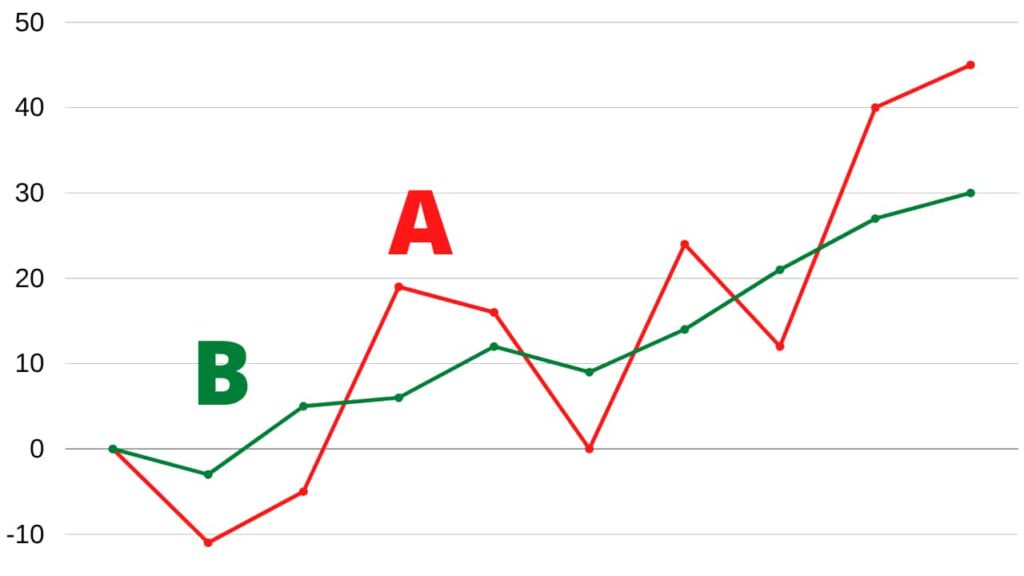Most beginner traders have wildly unrealistic expectations of how much they can make trading. Such unrealistic expectations can lead to an array of bad trading habits and ultimately blowing up your account. The purpose of this article is to present some realistic expectations for beginners as well as how to set the most effective investment goals. Regardless of your trading or investing style, setting smart goals can be very beneficial to your bottom line.
What are Realistic Trading Expectations
Before we get into how to set trading goals, let’s first talk about realistic expectations for your trading. If you have unrealistic expectations, you will also set unrealistic goals which can be very demotivating and counterproductive.
Due to the marketing material spread by sketchy trading gurus, some brokerages, and other shady marketers beginning traders typically expect way too much. Just to give you a rough benchmark, Warren Buffet who is often considered to be one of the best investors of all time has managed to achieve an annual return of about 17% over a 30-year time-frame. You really should not expect to beat this figure – even after watching a few ‘trading tutorials’ or going through some ‘day trading courses’. Note that this does not mean that it is impossible to achieve an annual return greater than 17% in any given year. It just means that consistently achieving such a return over a long enough period of time is extremely difficult.
Note that I am talking about risk-adjusted returns. If you take on much more risk and are willing to accept higher volatility and bigger drawdowns, achieving higher returns becomes more viable. That said, this usually isn’t a long term solution since it isn’t possible to continue to trade a strategy after a drawdown of over 100%.
Historically speaking, the overall market (S&P500 index) has achieved an average annual return of about 8%. There are only very few professional money managers that have managed to consistently outperform the market – and remember, these are institutional investors that have dedicated their entire careers to trying to beat the market. Statistically, retail investors have performed much worse. This shows that even an average annual return of 8% is very good. That’s why investing in a stock market index is an excellent strategy. If you want to learn more about investing in index funds, check out my guide on index fund investing.

If you think that 8% is not very much, you have likely been influenced by some of the countless marketing campaigns from “trading gurus” and marketers. This is the case because selling a course that promises a return of 100% every month is much easier than selling a course that shows you how to achieve an annual return of 8%.
Once again, I want to reiterate that this does not mean that it is impossible to achieve a return much greater than 10% in any given year. You can certainly have a good year supported by a raging bull market where you achieve an absolutely outstanding return. In fact, the S&P500 index has had many years where it achieved an annual return of over 20%, 30%, or even 40%. But over a long enough time frame, your average annual trading return will converge against its true average. If this average is far above 10%, you would be considered one of the best investors on the planet.
I really don’t want to demotivate anyone with this article. I just want to give you the reality check that many beginning traders need. You can’t expect to become a full-time day trader within one or two years with a starting capital of $10’000 – no matter how many marketing campaigns try to tell you otherwise.
If you are just getting into trading and investing, try to think of the potential returns generated as a way to supplement, and not replace your income.
Investing is a very worthwhile endeavor even if you shouldn’t expect more than 10% per year. The real power of investing lies in compounding your returns. To illustrate this fact, look at the following chart. It shows how an annual return of 10% can turn an initial investment of only $10’000 into over $750’000 in a 30-year time span with a monthly contribution of $300.
{{CODEcompounding}}
Try entering your own values here to see what potential returns you can expect.
Last but not least, it is important to understand that achieving the highest possible return is not everything. To illustrate this, take a look at the following chart. The two plots both represent the equity chart of two different traders:

Trader A and trader B both achieved the exact same return (about 30%). Nonetheless, I would claim that trader B clearly outperformed trader A. Why is this?
Trader B achieved the same return but with a much smaller max drawdown and less volatility than trader A. This is a sign that trader B took on much less risk than trader A. If you asked an investor if they rather would invest in trader A or trader B, most investors would certainly choose trader B.
However, if you look at the following chart, the answer isn’t as obvious:

Trader A achieved a much higher total return than trader B, but it was accomplished with greater volatility and a higher max drawdown. So depending on your appetite for risk, and financial situation, you might prefer trader A or trader B.
The point that I am trying to convey is that personal preferences matter. A strategy that achieves an annual return of 20% is not necessarily better than a strategy that achieves an annual return of 5%. This totally depends on the point of view which is determined by the investor and their preferences.
That said, there certainly are ways to evaluate and compare the performance of different strategies. If you want to learn how to effectively evaluate trading strategies, I recommend watching the following video.
Setting Trading Goals
After this short reality check, let’s get into the main topic of this article, namely setting trading goals. Before we discuss how to set the best possible trading goals, let me first outline some general practices for setting the most effective goals. For this, let me introduce you to the S.M.A.R.T. goal framework:
- Specific: You should clearly define your goals
- Measurable: The progress towards your goal should be trackable
- Attainable: While still being challenging, the goal should not be out of your reach
- Realistic: Be honest with yourself when setting goals
- Timeframe: Clearly define a time for when you want to have accomplished the goal
Besides following the S.M.A.R.T. framework when setting goals, studies have shown that people tend to achieve their goals much more often when they actually write them down and give regular progress updates to a friend or family member to hold them accountable.
When writing down your goal, try to answer the following questions:
- What resources do I need to achieve my goal?
- What do I have to do to achieve my goal within the specified amount of time?
- Who can help me achieve this goal?
Besides that, another great goal-setting guideline is to set goals for different time periods. Have a goal for the short-term, middle-term, and long-term. Ideally, your shorter-term goals should be small steps towards your longer-term goals.
Last but not least, it is very important to set process-oriented goals and not outcome-oriented goals. This is especially essential when it comes to trading goals. For example, your goal should NOT be something like “I want to make $20’000 in the next two months”. In trading, there is only so much you can control. You can do everything right but still end up losing on a trade. Even a strategy with a 70% win rate, loses 30% of the time. Furthermore, setting monetary goals often leads to you trying to force a profit out of an otherwise bad trade since you want to achieve your goal.
That’s why your goals should be process-oriented. If, for example, you are struggling with overtrading, your goal could be to not make more than one trade on any given day over the next month. This forces you to only focus on the best setups and not lose money from overtrading. Another good goal could be to not let your losses get out of control. More specifically, you could set yourself the goal to never let a position lose more than 3% before you close it. These are very specific goals that can easily be tracked, and that you have full control over (unlike specific monetary goals).
For inspiration, here is a brief list of a few aspects of your trading for which you could set goals:
- Risk management: Do you always have clearly defined risk metrics for your trades? If so, do you stick with them or not?
- Entries and exits: What process do you use to determine entry and exit points? Do you stick with them?
- Emotional trading: How do you handle your emotions when trading?
- Trading plan: Do you always have a clear trading plan? If so, do you stick with it?
In general, you should ask yourself how can you make better trades? Which aspects of your trading system do you need to work on?
In my opinion, the best way to track the progress towards your goals, and identify your strengths & weaknesses is by keeping a data-driven trading journal. When entering trade data into your trading journal, you are forced to re-live your trade. This is one of the best ways to think about what you did good, what you did poorly, and how to improve your next trades.
If you want to learn how to keep the most effective trading journal, check out my guide on the best trading journal software.
Conclusion
Let me quickly sum up the most important points of this post. First and foremost, it is important to understand that, on average, retail investors (and even professionals) underperform the general market by a wide margin). No matter what online trading gurus try to tell you, consistently achieving an annual return of 10% is extremely good. So if you are getting into trading, don’t set yourself up for disappointment by expecting to become rich within a couple of years.
When setting investment goals, try to follow the S.M.A.R.T. (Specific, Measurable, Attainable, Realistic, Timeframe) framework. Furthermore, make sure to actually write down your goals. Lastly, hold yourself accountable by telling someone about your goals. Ideally, try to give regular progress updates. Studies have shown that people that do this tend to achieve their goals more often that people that don’t.
In addition to that, make sure to focus on process-oriented, and not outcome-oriented goals.
Last but not least, make sure to consistently track your progress by keeping a data-focused trading journal. This allows you to identify any weakness and improve upon them. In my opinion, this is the best way for traders to become better.
If you don’t yet have a sophisticated trade tracker to measure your progress, make sure to check out my guide on the best trading journals.


I have to be honest and say that as for now I know nothing about trading, though I have been thinking about getting into it and I am glad that I have found you so I can learn about it. I am sure that not just me, but everyone should have a mentor who would show and teach how to set realistic investment goals and what are realistic trading expectations in order to become successful in a trade market.
I am looking forward to continuing to learn from you, thank you.
Sunny
Hi Sunny,
I am happy to hear that you liked this post.
This is another very important point that you have made that I think is very valid for me to use because when a person has an investment,it is important to understand those goals and also to be able to make them work for me too. This that you have pointed out here should really help me to do just that. Thanks so much for this.
Hi Louis,
Thanks for waking me up and showing me reality. Seriously I was living in dreams till I read your Realistic Trading Expectations article. I was thinking all the time to make big profits in trading. Now I know thats not the way it work in trading.
I don’t see anymore article coming from you. Will you be sending more articles for my learning or thats it.
Thanks
Harry
Hi Harry,
You should receive more emails with links to educational content every few days.